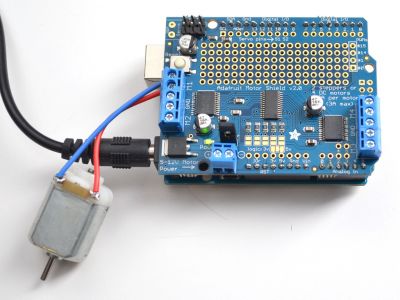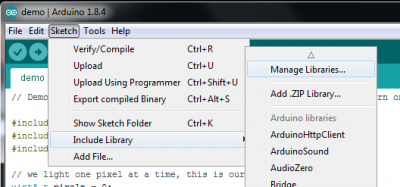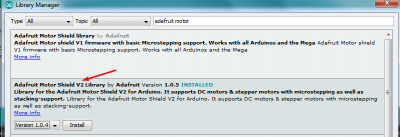Difference between revisions of "Adafruit Motor Shield V2"
| Line 41: | Line 41: | ||
[[File:Adafruit products motor.png|400px]] | [[File:Adafruit products motor.png|400px]] | ||
| + | |||
| + | Once you've installed the library, you can open an example sketch to understand how the library works. To do this, go to | ||
| + | |||
| + | File -> Examples -> Adafruit Motor Shield V2 Library -> DC Motor Test | ||
| + | |||
| + | Once open, you should see this: | ||
| + | |||
| + | <syntaxhighlight lang=c style="border:3px dashed pink"> | ||
| + | /* | ||
| + | This is a test sketch for the Adafruit assembled Motor Shield for Arduino v2 | ||
| + | It won't work with v1.x motor shields! Only for the v2's with built in PWM | ||
| + | control | ||
| + | |||
| + | For use with the Adafruit Motor Shield v2 | ||
| + | ----> http://www.adafruit.com/products/1438 | ||
| + | */ | ||
| + | |||
| + | #include <Adafruit_MotorShield.h> | ||
| + | |||
| + | // Create the motor shield object with the default I2C address | ||
| + | Adafruit_MotorShield AFMS = Adafruit_MotorShield(); | ||
| + | // Or, create it with a different I2C address (say for stacking) | ||
| + | // Adafruit_MotorShield AFMS = Adafruit_MotorShield(0x61); | ||
| + | |||
| + | // Select which 'port' M1, M2, M3 or M4. In this case, M1 | ||
| + | Adafruit_DCMotor *myMotor = AFMS.getMotor(1); | ||
| + | // You can also make another motor on port M2 | ||
| + | //Adafruit_DCMotor *myOtherMotor = AFMS.getMotor(2); | ||
| + | |||
| + | void setup() { | ||
| + | Serial.begin(9600); // set up Serial library at 9600 bps | ||
| + | Serial.println("Adafruit Motorshield v2 - DC Motor test!"); | ||
| + | |||
| + | if (!AFMS.begin()) { // create with the default frequency 1.6KHz | ||
| + | // if (!AFMS.begin(1000)) { // OR with a different frequency, say 1KHz | ||
| + | Serial.println("Could not find Motor Shield. Check wiring."); | ||
| + | while (1); | ||
| + | } | ||
| + | Serial.println("Motor Shield found."); | ||
| + | |||
| + | // Set the speed to start, from 0 (off) to 255 (max speed) | ||
| + | myMotor->setSpeed(150); | ||
| + | myMotor->run(FORWARD); | ||
| + | // turn on motor | ||
| + | myMotor->run(RELEASE); | ||
| + | } | ||
| + | |||
| + | void loop() { | ||
| + | uint8_t i; | ||
| + | |||
| + | Serial.print("tick"); | ||
| + | |||
| + | myMotor->run(FORWARD); | ||
| + | for (i=0; i<255; i++) { | ||
| + | myMotor->setSpeed(i); | ||
| + | delay(10); | ||
| + | } | ||
| + | for (i=255; i!=0; i--) { | ||
| + | myMotor->setSpeed(i); | ||
| + | delay(10); | ||
| + | } | ||
| + | |||
| + | Serial.print("tock"); | ||
| + | |||
| + | myMotor->run(BACKWARD); | ||
| + | for (i=0; i<255; i++) { | ||
| + | myMotor->setSpeed(i); | ||
| + | delay(10); | ||
| + | } | ||
| + | for (i=255; i!=0; i--) { | ||
| + | myMotor->setSpeed(i); | ||
| + | delay(10); | ||
| + | } | ||
| + | |||
| + | Serial.print("tech"); | ||
| + | myMotor->run(RELEASE); | ||
| + | delay(1000); | ||
| + | } | ||
| + | |||
| + | </syntaxhighlight> | ||
==Servo Motors== | ==Servo Motors== | ||
Revision as of 09:14, 18 July 2024
Adafruit Motor Shield V2
Adafruit Motor Shield V2 allows you to easily control the speed and direction of 4 DC motors, the position of 2 servo motors and the steps of 2 stepper motors. The shield is made for the Arduino UNO and can be easily installed on it.
The shield uses I2C to operate, which is a communication protocol between the Arduino and the shield. This means that all the other non-I2C pins (so everything other than A4 and A5) can be uses to read sensor data or control other things. I2C also means that the shield is stackable. You can use up to 32 shields at the same time, meaning that you can use up to 64 steppers or 128 DC motors!
!The Adafruit Motor Shield can handle 4 DC motors with each using a maximum of 1,3A, so it's made for small to medium sized motors!
DC Motors
One Adafruit Motor Shield can be used to control the speed and direction of 4 DC motors at the same time. Here I'll give you an example of how to run 1 motor.
Wiring
Now let's wire a motor to the shield.
Connect the wires of your motor to one of the terminals. In our case you'll use the M1 terminal.
Now connect your power supply to the power terminals of the shield. You'll want to connect a barrel jack to the power terminal to attach an appropriate external power source to the Shield. The Shield will not function without an external power source!
Connect the positive side of the power terminal to the positive side of the barrel jack. Connect the negative side of the power terminal to the negative side of the barrel jack.
In the picture two motors are attached, but in our example we'll only use 1.
Programming
To program the shield, we need to upload a code to the Arduino UNO using Arduino IDE. Luckily we don't need to write the whole code ourselves, but we can start with examples that are in the the Adafruit Motor Shield V2 library.
Do you have Arduino IDE? If not, go to https://www.arduino.cc/en/software and download the latest version.
Open Arduino IDE and go to Sketch -> Include Library -> Manage Libraries...
Now look for Adafruit Motor Shield in the search bar and install Adafruit Motor Shield V2 Library by Adafruit.
Once you've installed the library, you can open an example sketch to understand how the library works. To do this, go to
File -> Examples -> Adafruit Motor Shield V2 Library -> DC Motor Test
Once open, you should see this:
/*
This is a test sketch for the Adafruit assembled Motor Shield for Arduino v2
It won't work with v1.x motor shields! Only for the v2's with built in PWM
control
For use with the Adafruit Motor Shield v2
----> http://www.adafruit.com/products/1438
*/
#include <Adafruit_MotorShield.h>
// Create the motor shield object with the default I2C address
Adafruit_MotorShield AFMS = Adafruit_MotorShield();
// Or, create it with a different I2C address (say for stacking)
// Adafruit_MotorShield AFMS = Adafruit_MotorShield(0x61);
// Select which 'port' M1, M2, M3 or M4. In this case, M1
Adafruit_DCMotor *myMotor = AFMS.getMotor(1);
// You can also make another motor on port M2
//Adafruit_DCMotor *myOtherMotor = AFMS.getMotor(2);
void setup() {
Serial.begin(9600); // set up Serial library at 9600 bps
Serial.println("Adafruit Motorshield v2 - DC Motor test!");
if (!AFMS.begin()) { // create with the default frequency 1.6KHz
// if (!AFMS.begin(1000)) { // OR with a different frequency, say 1KHz
Serial.println("Could not find Motor Shield. Check wiring.");
while (1);
}
Serial.println("Motor Shield found.");
// Set the speed to start, from 0 (off) to 255 (max speed)
myMotor->setSpeed(150);
myMotor->run(FORWARD);
// turn on motor
myMotor->run(RELEASE);
}
void loop() {
uint8_t i;
Serial.print("tick");
myMotor->run(FORWARD);
for (i=0; i<255; i++) {
myMotor->setSpeed(i);
delay(10);
}
for (i=255; i!=0; i--) {
myMotor->setSpeed(i);
delay(10);
}
Serial.print("tock");
myMotor->run(BACKWARD);
for (i=0; i<255; i++) {
myMotor->setSpeed(i);
delay(10);
}
for (i=255; i!=0; i--) {
myMotor->setSpeed(i);
delay(10);
}
Serial.print("tech");
myMotor->run(RELEASE);
delay(1000);
}
Servo Motors
Wiring
Programming
Stepper Motors
Wiring
Programming



